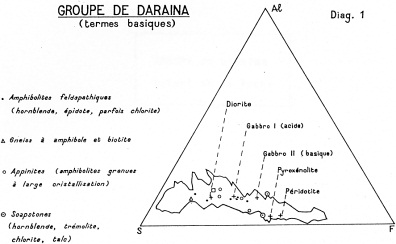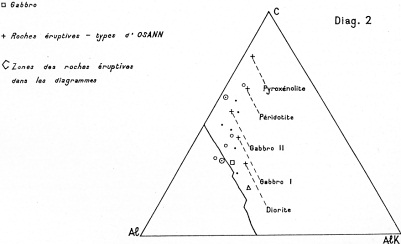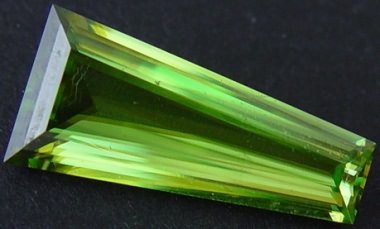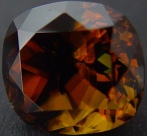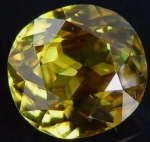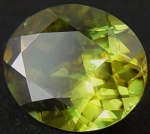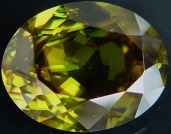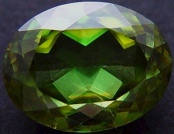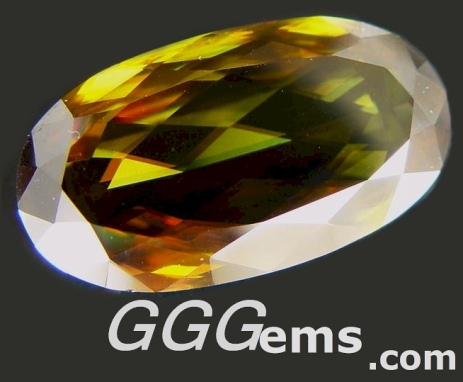 Titanite crystallographic properties: Monoclnic. Titanite crystallographic properties: Monoclnic. |
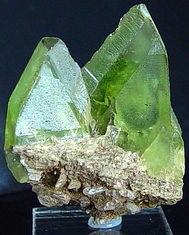 |
| Ca Ti (O ISiO4) |
|
| Hardness 5 - 5.5 |
|
| Density 3.52 to 3.54 |
| Refractive index: 1.885 - 2.050 |
| Bi-refraction: 0.105 to 0.135 |
| Dispersion: 0.051 |
|
 Colors : Yellow, greenish-yellow, brown-orange, green (chrome) Colors : Yellow, greenish-yellow, brown-orange, green (chrome) |
|
 Chemical Properties: Calcium Titanium Silicate Chemical Properties: Calcium Titanium Silicate |
| Often includes (Nb, Cr, F, Na, Fe, Mn, Sn, V or Yt). |
|
 Occurrences: In the pegmatites (Madagascar). Intrusive metamorphic rocks. Occurrences: In the pegmatites (Madagascar). Intrusive metamorphic rocks. |
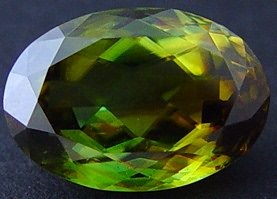 |
|
<<< Chrome Sphene 15,30 carats. with red sparkles |
|
|
|
The birefringence of sphene is twice that of the zircon, which |
|
|
|
facilitates its identification. This stone shows a exceptionally |
|
|
|
high fire. Unlike the same zircon color, it is distinctly dichroic. |
|
|
|
Its refractive index is beyond the scale of the refractometer. |
|
|
|
|
|
|
|
|
|
| In this calcium and titanium silicate, rare earth replace calcium up to 14%, aluminum, |
|
| iron and chromium may also be present. |
|
|
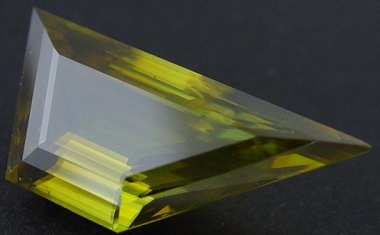 |
<<< Typical color of a sphene from northern Madagascar. 26.64 cts. |
|
|
 Lithology and summary petrography : Lithology and summary petrography : |
| The series of Daraina includes acid rock and intermediate or basic rocks, usually shale. The most common |
| acid facies is a feldspar sericite schist often pyriteous. The presence of small feldspathycs tonsils |
| oriented in a frame packed finely schisteous where dominate sericite evokes both at the naked eye than at |
| the microscope the structure of some mylonites. There are also benches of microgranites with big |
| euhedral orthoclase which are probably relics of the original formations, volcanic rocks |
| or eruptive acids. |
|
| Basic or intermediate facies, of varied texture and composition, all contain a high proportion |
| of amphybole and epidote, with the exception of some chloritic varieties. All intermediates are represented |
| between porphyritic textures, oriented or not, at large euhedral plagioclase and granoblastic textures |
| or homogeneous lépidoblastiques. |
|
|
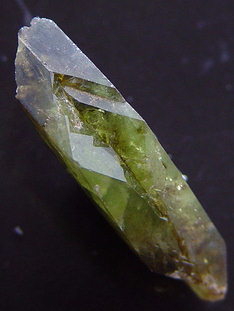 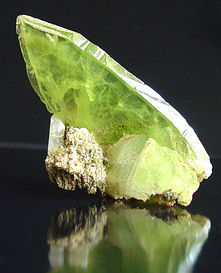 |
| Typical crystals of sphene with a top |
| beveled. >>> |
|
| The term Sphên "splitting wedge" is |
| referring to the shape of crystals, then |
| that the word "titanite" refers to |
| its chemical composition. |
|
| Crystals, generally well shaped, have |
| different facies, sometimes flattened in house |
| double roof (typical case of intrusive and |
| metamorphic rocks), sometimes elongated and |
| twinned by penetration with an aspect of |
| channe. |
| (typical case of sphenes from alpine slots). |
| We can found large crystals in |
| pegmatites. |
|
| The monoclinic system in which the sphene develops, has three crystallographic axes of unequal lengths, |
| two intersecting at an oblique angle, the third being perpendicular to the plane of the other two. |
| The monoclinic crystals are biaxial. |
|
 Metamorphism of basic igneous rocks. Metamorphism of basic igneous rocks. |
|
| The Group of Daraina is an outstanding example of a precambrian eruptive system with varied terms, |
| metamorphosed under medium metamorphic intensity conditions. |
|
|
| The group of Daraina also stands with a significant copper mineralization which has been the subject of research |
| in 1954. It turned out that we can not separate metallogenic activities from méthamorphic processes. In |
| copper belt itself, in the valley of Antsahandrevo, the most important mineralization ( massive chalcosine lens of |
| Androtsara-Matsaborivaky) is within a few meters depth of magnifier doleritic loupe, |
| flushing at the side of a hill between amphibole gneiss and epidote. |
|
|
|
|
|
|
|
|
|
|
|
|
|
|
|
|
|
|
|
|
|
|
|
|
|
|
|
|
|
|
|
|
|
Exceptional formation of chrome |
|
|
sphene crystals in their gangue. |
|
|
|
|
|
|
|
|
|
|
|
|
|
(This piece of collection weights 1290 grams.) |
|
|
|
|
|
|
|
|
|
|
|
|
|
|
|
|
|
|
|
|
|
|
|
|
|
|
|
|
|
|
|
|
|
|
|
|
|
|
|
|
|
|
© Image A. Darbellay |
|
|
|
|
|
|
|
 Metamorphism of basic igneous rocks. (Continued) Metamorphism of basic igneous rocks. (Continued) |
|
| The blue-green color under the microscope, which characterizes most of the amphiboles of this complex, |
| is not accompanied by substantially different optical properties from those of common hornblende. Note that |
| the refraction and birefringence of the blue-green amphibole are particularly low. These characters closer |
| to the sodium hornblendes of the group of cataphorites, French geologists are used to a chemical analyze |
| in order to indicate the composition of that amphibole. According to the ionic composition reported in 96 (4x24) |
| oxygen, amphibole can be regarded as a mixture of the following three varieties defined by Winchell: |
| Ferriferous tschermakite, Edenite, and a chemical member of the Edenites' family. Possible impurities are epidote |
| and sphene that could have remained in inclusion within amphibole grains. Note that the presence of sphene |
| is likely to significantly alter the figures for titanium. The blue-green amphibole in thin lamella is due to the high |
| proportion of ferric iron and not the soda content denied by the analysis. |
|
|
|
|
|
|
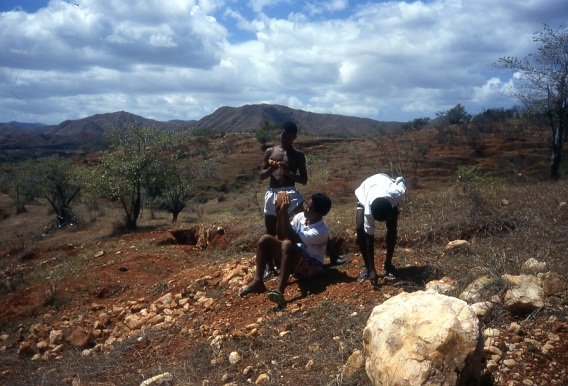 |
|
|
|
|
|
|
|
|
|
Sphene occurrence in northern Madagascar. © Image J. Darbellay |
|
|
|
|
It is at a modest depth that the stones are usually extracted. |
|
|
|
 |
Sphenes / Visual Catalog / Safari |
 |
| Geological references: A. Lacroix, P. Brenon, R.Dormois, H.Bessairies, |
|
| H. de la Roche, A Poldervaart. |
Your guide to GGGems |
|
Text and images : |
|
|
|
|
|
|
A. Darbellay |
|
|
An article of : |
|
 |
|
 |
 |
|






